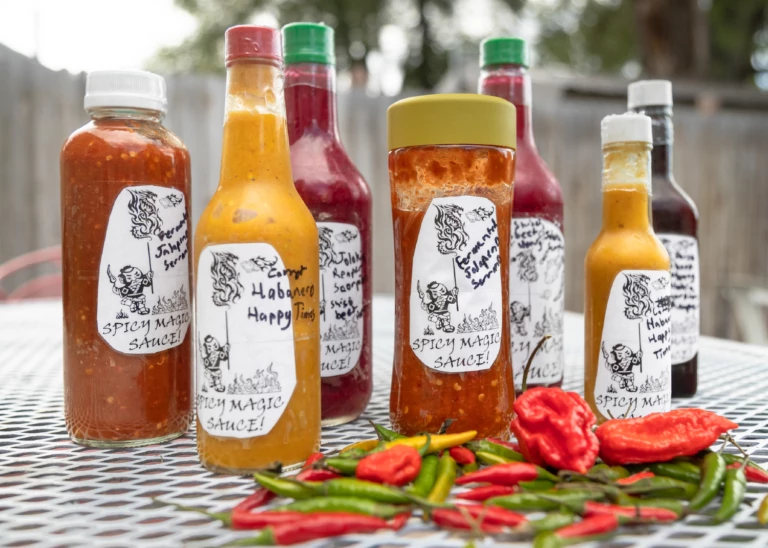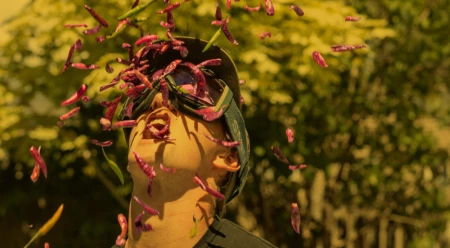A Painful Conversation with Skier and Hot Sauce Maker Carston Oliver
As seen in the November 2019 Journal. For the recipe behind Carston’s Spicy Magic Sauce, scroll to the end of the story.
Although my tongue felt as if it might melt, Carston Oliver assured me I was not, in fact, going to die.
“That’s just the capsaicin,” he told me, as he calmly ordered some milk and I stuffed my fire-filled mouth with napkins. “It’s not giving you a chemical burn or anything. It just binds to the pain receptors that create a burning sensation. Wash it off and you’ll be fine.”
It was my first trip with Carston, and we were at a sushi place in Japan. I’ve always thought I could handle spice, so when he pulled out a Tic Tac container filled with an orange powder and sprinkled it on his nori, I was curious. Seeing my interest, he reached across the table.
“Want some?”
That’s when I realized I knew nothing about spice, and that Carston is insane.
Well, maybe not insane, but the professional skier and mountain biker has been making his own hot sauce and growing his own peppers for so long it’s become a trademark: His pro-model ski is called the “Chipotle Banana,” and the first 25 pairs come with a bottle of hot sauce.

Carston (center) makes this surprisingly sweet sauce with Bhut jolokia (ghost peppers), Carolina Reapers and Trinidad Moruga Scorpions, the latter of which are the first and second hottest peppers in the world.Photo: Mary McIntyre
At the sushi place, it turned out I didn’t die. After a healthy dose of 2% milk and humility, my mouth eventually cooled down. I’ve been on numerous trips with Carston since, but now whenever he offers that Tic Tac container, I refuse. Because, while I know it won’t kill me, I like my tongue and I hate the taste of napkins.
Sakeus Bankson: Have you always liked spicy foods or was it gradual?
Carston Oliver: It started at an early age. Apparently when I was really young, I would pick jalapeños out of the garden and munch on them like apples. I’d try to share them with the dogs, which would send them running because a dog doesn’t want to eat a spicy pepper.
As I grew up, I tried more varieties and hotter and hotter things, and figured out what I like. Lo and behold, now I’m making three or four varieties of hot sauce every year and growing 20 different peppers in the yard.

Funky Fermenty, Carrot Habanero Happy Times and Purple Pleasure Pain Cave—the names may be funny, but humor doesn’t ease the burn. Be especially careful of the last one: Along with honey, beets and shiso, Carston makes this surprisingly sweet sauce with Bhut jolokia (ghost peppers), Carolina Reapers and Trinidad Moruga Scorpions, the latter of which are the first and second hottest peppers in the world. Photo: Mary McIntyre
SB: Most people avoid spicy things. What’s the attraction?
CO: I’ve always enjoyed spicy things and everything that goes with them: It increases circulation, it gives you a bunch of energy, it stimulates a bit of a happy effect. People always say, “You can’t taste your food. You always make it so hot.” But actually, it seems to open things up and bring out a lot of background flavors you don’t get otherwise.
SB: What’s the hottest pepper you’ve eaten, grown or made into a sauce?
CO: The mildest sauce I make would be similar to sriracha. I have some Capsicum chinense varieties in my garden, like Trinidad Moruga scorpions and Carolina Reapers, that are pretty silly hot; a ghost pepper is probably a third as spicy as those. If I eat a raw chunk my whole face goes numb, but they also have a really unique flavor. Some of my recent sauces have been an attempt to tone down those mega-hots to where they’re approachable and people can actually taste them.

This is what 1.2 million Scoville Units looks like. Eric Balken breathes deep after taking a bite of a raw Trinidad Moruga Scorpion, one of the hottest peppers in the world. Photo: Mary McIntyre
SB: When did you start making your own hot sauce?
CO: Probably 10 years ago or more, around my first year of college. A buddy and I looked up a hot sauce recipe on a whim and decided to make a bunch and give it to people for Christmas. It just grew from there.
SB: Have you had any disasters?
CO: I’ve made two big mistakes. One happened while I was bottling. I wasn’t wearing safety glasses, and the bottle burped and splashed boiling habanero and ghost pepper juice into my eye.
The second happened when I had some friends over for dinner. When you’re working with superhots, you have to be really careful with the pan temperature; if you vaporize the juices, you essentially create pepper spray. I’d used my main pan to make a batch of superhot sauce earlier and hadn’t cleaned it well enough. When I stuck it on the stove, it started smoking and cleared the entire house. We couldn’t go back in for an hour.

Bite into a raw Trinidad Moruga Scorpion pepper, and it will actually taste sweet for the first few seconds–until the capsaicin kicks in. Then it feels like you’re going to die. Just ask Justin Gibbs. Photo: Mary McIntyre
SB: What’s the best way to neutralize something that’s too spicy?
CO: Capsaicin is carried on oils, which is why water doesn’t help. If your mouth is on fire, you want something with some fat in it, like milk or yogurt, which will bind to the capsaicin and carry it away. If it’s on your skin, just wash it with soap. That’s why soap has lots of oils in it, especially dish soap.
With your eyes, stick your head in the sink and flush them with water thoroughly until it’s gone. Basically, if you remove the chemical, you remove the stimulus and the burning stops.
SB: On a trip to Korea, you traded some dried peppers with our host, Mr. Choi. Can you tell me about that?
CO: Mr. Choi noticed I was sprinkling my pepper spice on everything, and toward the end of our stay he brought out this little jar of finely ground chilies from his garden. He asked if I liked them and just gave me the whole jar. I wanted to give him something in exchange, so I grabbed some from my stash. He wasn’t down with a straight-across exchange; he went back into the kitchen and got a bigger jar.
Similar things have happened elsewhere. I’ve ridden quite a bit with Kazushi Yamauchi, the Japanese snowboarder people call the “Orange Man,” and when I was in Japan last year we ran into him at a trailhead. He came out of his van with this old mustard jar and said in broken English, “Carston, every time I see you, you always sprinkle pepper, more pepper, more pepper. Here’s some pepper I grew in my garden.” So I went to the car and gave him a little bag of Thai chilies. Apparently, the international pepper exchange is alive and well.

Carston Oliver, a Patagonia ski and mountain bike ambassador, styles a 360 in the Utah backcountry. Photo: Mary McIntyre
It isn’t all numb faces and swollen tongues; Carston makes hot sauces for regular humans as well. “Spicy Magic Sauce” is one of Carston’s base hot sauces, and can be easily tuned for flavor, color, and heat level. However, novices beware: it may be one of his more timid recipes, but it still delivers a Sriracha-level zing. Apply with caution.
Spicy Magic Sauce
Ingredients:
1 onion, chopped
4 to 6 garlic cloves, chopped
1 tablespoon sesame chili oil
2 cups water
1 – 1½ cups chopped root vegetables (carrots for an orange sauce, beets for a deep purple, or a blend for red)
~1 inch of fresh ginger, sliced
~1/4 cup Thai chilis, to taste (dry, or finely diced fresh)
12 – 30 fresh habanero peppers, minced (add or subtract to tune heat)
2 – 3 tablespoons lime juice
2 tablespoons rice vinegar
1 teaspoon salt
Directions:
- In a large skillet or saucepan, sauté onion and garlic in chili oil until onion begins to caramelize and garlic is soft.*
- Add root vegetables, ginger, Thai chilis and water. Bring to a boil.
- Reduce heat and simmer until root vegetables are soft.
- Add habaneros. Continue to simmer on low heat for another 5 to 10 minutes.
- Remove from heat and transfer to blender or food processor.
- Add lime juice, vinegar and salt. Puree until smooth.**
(Typically keeps for around six months in the refrigerator.)
Variations:
For a milder sauce with a more neutral flavor, replace some or all habaneros with capsicum annuum varieties like cayenne peppers or Thai chilis.
For a brighter, livelier flavor and extra heat, replace some habaneros with super-hot capsicum chinense varieties like 7 Pot Douglahs, Bhut jolokias, Carolina Reapers or Trinidad Moruga Scorpions.
For blazing heat, replace all habaneros with super-hot varieties.***
WARNINGS
*Clean your saucepan well after cooking this recipe. If a poorly cleaned pan is overheated, any remaining pepper oils will vaporize and cause extreme aggravation to the eyes, mouth, nose, skin or any other exposed body part.
**Safety glasses are recommended when blending or bottling hot sauce.
***Gloves are recommended when chopping or handling super-hot peppers.

